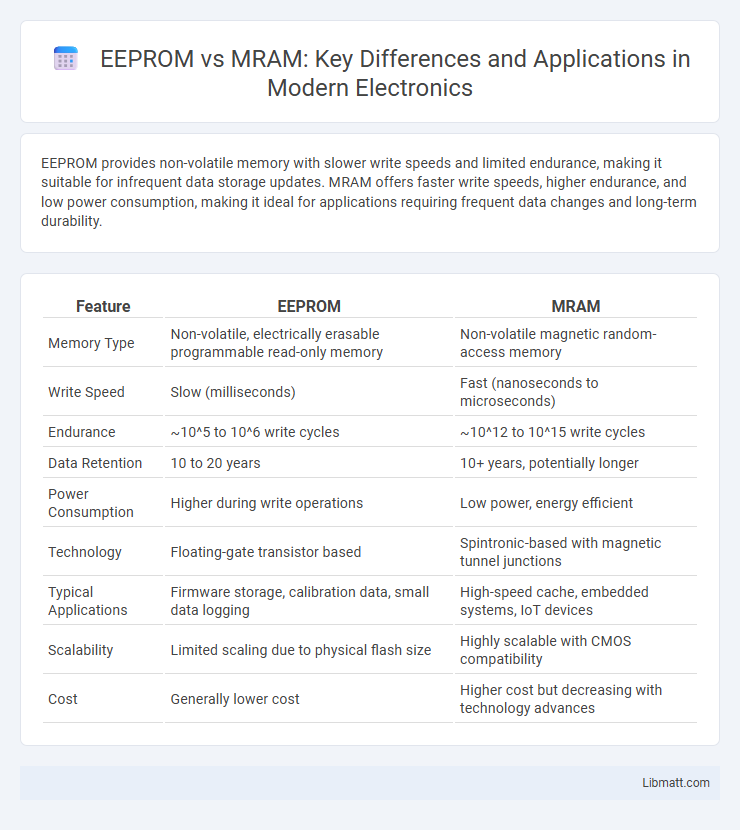EEPROM provides non-volatile memory with slower write speeds and limited endurance, making it suitable for infrequent data storage updates. MRAM offers faster write speeds, higher endurance, and low power consumption, making it ideal for applications requiring frequent data changes and long-term durability.
Table of Comparison
| Feature | EEPROM | MRAM |
|---|---|---|
| Memory Type | Non-volatile, electrically erasable programmable read-only memory | Non-volatile magnetic random-access memory |
| Write Speed | Slow (milliseconds) | Fast (nanoseconds to microseconds) |
| Endurance | ~10^5 to 10^6 write cycles | ~10^12 to 10^15 write cycles |
| Data Retention | 10 to 20 years | 10+ years, potentially longer |
| Power Consumption | Higher during write operations | Low power, energy efficient |
| Technology | Floating-gate transistor based | Spintronic-based with magnetic tunnel junctions |
| Typical Applications | Firmware storage, calibration data, small data logging | High-speed cache, embedded systems, IoT devices |
| Scalability | Limited scaling due to physical flash size | Highly scalable with CMOS compatibility |
| Cost | Generally lower cost | Higher cost but decreasing with technology advances |
Introduction to Non-Volatile Memory
Non-volatile memory retains data without power, essential for persistent storage in electronic devices. EEPROM (Electrically Erasable Programmable Read-Only Memory) stores data using charge trapping in floating gate cells, allowing byte-level erase and write cycles but suffers from limited endurance and slower speeds. MRAM (Magnetoresistive Random-Access Memory) utilizes magnetic tunnel junctions to store data magnetically, offering faster read/write performance, higher endurance, and greater energy efficiency compared to traditional EEPROM technology.
What is EEPROM?
EEPROM (Electrically Erasable Programmable Read-Only Memory) is a non-volatile memory technology used to store small amounts of data that must be saved when power is removed. Unlike MRAM, EEPROM allows data to be electrically erased and reprogrammed byte by byte, making it ideal for applications requiring frequent updates and precise memory control. Your choice between EEPROM and MRAM depends on the trade-offs between write endurance, speed, and data retention needs.
What is MRAM?
MRAM (Magnetoresistive Random Access Memory) is a non-volatile memory technology that stores data using magnetic states instead of electric charge, offering faster write speeds and higher endurance than traditional EEPROM. Unlike EEPROM, which relies on electron trapping to retain data, MRAM uses magnetic tunnel junctions to achieve persistent storage with low power consumption and near-instantaneous data access. MRAM's durability, scalability, and energy efficiency make it an attractive choice for advanced computing and embedded system applications where rapid, reliable memory retention is critical.
Key Differences Between EEPROM and MRAM
EEPROM (Electrically Erasable Programmable Read-Only Memory) uses charge storage on a floating gate to retain data, resulting in slower write speeds and limited endurance compared to MRAM (Magnetoresistive Random-Access Memory), which stores data using magnetic states for faster writes and virtually unlimited write cycles. MRAM operates with low power consumption and high durability, making it ideal for applications requiring frequent data updates, while EEPROM is better suited for storing infrequently changed data due to its slower performance and write limitations. Understanding these differences helps you choose the right memory type based on speed, endurance, and power efficiency needs.
Speed and Performance Comparison
MRAM offers significantly faster read and write speeds compared to EEPROM, with access times in the nanosecond range versus EEPROM's microseconds. This speed advantage makes MRAM ideal for applications requiring rapid data storage and retrieval, such as real-time processing systems. Your choice between EEPROM and MRAM should consider these performance differences to optimize system responsiveness and efficiency.
Endurance and Data Retention
EEPROM typically offers endurance of around 1 million write/erase cycles with data retention up to 10-20 years, making it suitable for applications requiring moderate rewrite frequency and long-term storage. MRAM provides significantly higher endurance, often exceeding 10^15 write cycles, coupled with non-volatile data retention exceeding 20 years, enabling robust performance in high-write and long-retention environments. The superior endurance and comparable or better data retention of MRAM make it ideal for next-generation memory technologies demanding high reliability and longevity.
Power Consumption Analysis
EEPROM consumes higher power due to its reliance on charge storage and erase/write cycles that demand significant current, especially during data retention and rewriting. MRAM offers lower power consumption by using magnetic states to store data, enabling faster write speeds and reduced energy usage, which enhances battery life in portable devices. Your choice between EEPROM and MRAM should consider MRAM for energy-efficient applications requiring frequent writes and long-term data retention with minimal power drain.
Application Areas for EEPROM and MRAM
EEPROM is widely used in applications requiring non-volatile memory with slow write speeds, such as BIOS settings, microcontroller firmware storage, and calibration data retention. MRAM excels in high-speed, high-endurance applications like cache memory, real-time data logging, and aerospace systems where rapid access and data integrity are critical. Your choice between EEPROM and MRAM depends on the need for write endurance, speed, and data retention in your specific use case.
Cost Considerations
EEPROM typically offers lower initial costs due to established manufacturing processes and widespread use in small-scale applications, while MRAM incurs higher upfront expenses because of advanced materials and fabrication complexity. Despite higher initial costs, MRAM provides superior endurance and energy efficiency, potentially reducing total cost of ownership over time in high-performance or frequent write scenarios. The choice between EEPROM and MRAM depends on balancing upfront budget constraints against long-term operational cost benefits.
Future Trends in Non-Volatile Memory Technologies
Future trends in non-volatile memory technologies highlight MRAM's potential to surpass EEPROM due to its faster write speeds, higher endurance, and lower power consumption. Emerging MRAM variants like STT-MRAM and SOT-MRAM promise increased scalability and integration with CMOS processes, positioning them as key players for next-generation embedded memory solutions. Your choice between EEPROM and MRAM will increasingly depend on application-specific demands for speed, durability, and energy efficiency in IoT and AI devices.
EEPROM vs MRAM Infographic

 libmatt.com
libmatt.com